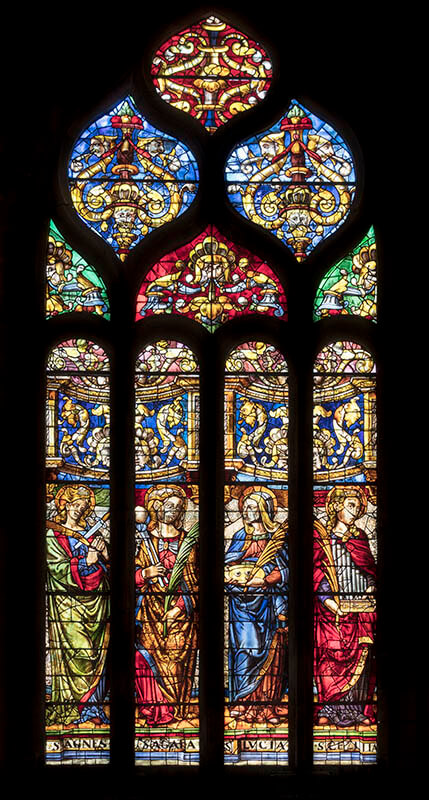Sevilla, a city known for its vibrant culture, flamenco rhythms, and architectural marvels, houses one of the most iconic structures in the world – the Cathedral of Saint Mary of the See. This cathedral, a blend of history, art, and spirituality, stands as a testament to the city’s rich heritage and the ever-evolving tapestry of cultures that have left their mark on its stones. In this blog post, we’ll embark on a journey through the corridors of this magnificent structure, uncovering stories etched in its walls and the faith that resonates within its chambers.


Maria Lopez Guevara
Meet Maria Lopez, a seasoned traveler and a passionate writer. Born and raised in Malaga, Maria has a deep love for her Spanish roots. She has spent years exploring the nooks and crannies of Spain, with a particular fondness for Andalusia. Maria has a knack for capturing the essence of a place in her writings, making her readers feel as if they are right there with her. Today, she takes us on a journey from her hometown, Malaga, to the enchanting city of Sevilla.
Sevilla’s Cathedral – An In-depth Overview
Sevilla’s Cathedral, officially christened as the Cathedral of Saint Mary of the See, stands majestically in the historic center of Seville, the vibrant capital of Andalusia, Spain. This architectural marvel is not only the largest Gothic cathedral globally but also the third-largest church in the world. Its sheer size and grandeur are a testament to the ambitious vision of its creators and the city’s importance during the time of its construction.
In 1987, Sevilla’s Cathedral, along with the adjoining Alcázar palace complex and the Archivo de Indias, was declared a UNESCO World Heritage site. This prestigious designation is a nod to the cathedral’s exceptional cultural, historical, and architectural value. It’s not just a place of worship but a monument that encapsulates the spirit and evolution of Seville over the ages.
Each year, millions of tourists and pilgrims from around the world flock to Seville, drawn by the cathedral’s magnetic allure. Whether they come to marvel at its architectural brilliance, delve into its rich history, or seek spiritual solace, visitors are invariably awed by the cathedral’s magnificence.
Historical Background of Sevilla’s Cathedral
Sevilla’s Cathedral, officially known as the Cathedral of Saint Mary of the See, is a remarkable structure that encapsulates the rich and diverse history of Seville, Andalusia, Spain. Its story is a fascinating journey through time, reflecting the city’s cultural shifts and architectural evolution.
The site’s original structure was the Aljama Mosque, constructed during the Almohad dynasty in the late 12th century. This mosque was a marvel of Islamic architecture, with a vast courtyard and an iconic minaret that later became the Giralda Tower. It stood as a symbol of Seville’s significance as a major Islamic cultural and administrative center.
However, the Reconquista, a series of campaigns by Christian states to recapture territory from the Moors, dramatically altered the site’s destiny. In 1248, King Ferdinand III of Castile captured Seville, and the Aljama Mosque was consecrated as a Christian cathedral. The Giralda Tower’s Islamic crescent was replaced with a Christian cross, but the Christian rulers wisely chose to preserve the mosque’s architectural elements, ensuring a continuity of Seville’s multicultural legacy.
By the early 15th century, Seville had grown in prominence, both economically and religiously. The city’s Christian leaders envisioned a cathedral that would reflect Seville’s newfound status and overshadow the former mosque’s memories. The famous declaration, “Let us build a church so beautiful and so grand that those who see it finished will think we are mad,” set the stage for the construction of the world’s largest Gothic cathedral.
The construction began in 1401 and spanned over a century, involving numerous architects, artisans, and craftsmen. The cathedral’s design evolved over time, incorporating Gothic, Renaissance, and Baroque elements. The main chapel, Capilla Mayor, with its stunning altarpiece, became the focal point, while the numerous chapels, each with its unique history and artwork, added to the cathedral’s complexity and beauty.
The Giralda Tower, originally the mosque’s minaret, underwent significant transformations. While its lower sections retained their Almohad design, the upper sections were redesigned in the Renaissance style, crowned with a bronze weathervane, the “Giraldillo,” representing faith. The tower’s blend of Islamic and Christian architectural elements stands as a symbol of Seville’s rich cultural fusion.
Over the centuries, Sevilla’s Cathedral has been more than just a place of worship. It has hosted royal ceremonies, including the wedding of Emperor Charles V and Isabella of Portugal. It also became the final resting place for several notable figures, including Christopher Columbus, whose tomb is one of the cathedral’s most visited attractions.
The cathedral’s interior is equally impressive, housing an extensive collection of religious art and relics. The Sacristía Mayor, the main sacristy, is renowned for its collection of silverware, while the Sala Capitular, the Chapter House, is adorned with exceptional paintings by renowned artists like Murillo.
The cathedral has also undergone various restorations and additions over the years. The 16th-century Renaissance-style Puerta del Príncipe (Prince’s Door) and the 19th-century neo-Gothic north facade are examples of architectural modifications that have contributed to the cathedral’s eclectic appearance.
The cathedral’s exterior is equally captivating, with its intricate stone carvings and magnificent flying buttresses. The Patio de los Naranjos, a beautiful courtyard filled with orange trees, offers a serene space for reflection and is a remnant of the original mosque’s courtyard.
Architectural Highlights of Sevilla’s Cathedral
Sevilla’s Cathedral, the world’s largest Gothic cathedral, is a masterpiece of architectural innovation and artistic expression. Its design intricacies and structural elements are a testament to the craftsmanship of the bygone era. Let’s delve into some of the most notable architectural highlights of this magnificent structure:
The Giralda Tower: A Blend of Cultures and Eras
Originally serving as a minaret for the Aljama Mosque, the Giralda Tower stands as a testament to Seville’s rich tapestry of cultures. The base of the tower retains its Almohad design, characterized by its intricate brickwork and arched windows. However, after the Reconquista, Christian additions brought Renaissance elements to the tower, culminating in the iconic bronze weathervane, the “Giraldillo,” symbolizing faith. This harmonious blend of Islamic and Christian architectural elements makes the Giralda an iconic symbol of Seville’s intertwined history.
Main Facade and Doorways: Artistic Grandeur at Every Entrance
The cathedral boasts several entrances, each exuding its distinct artistic flair. The Puerta del Perdón, for instance, is adorned with a mesmerizing Mudejar rose window. In contrast, the Puerta de la Asunción showcases Gothic archivolts, and the Renaissance-inspired Puerta del Príncipe features intricate reliefs of saints. Each doorway invites visitors into a world of architectural and artistic marvels, setting the tone for the wonders inside.
Capilla Mayor: The Heart of the Cathedral
Within the vast expanse of Sevilla’s Cathedral, the Capilla Mayor stands as a beacon of Gothic architectural and artistic brilliance. This main chapel, with its soaring ceilings and intricate stonework, encapsulates the essence of the cathedral’s spiritual and historical significance.
At the center of this architectural marvel is the retablo mayor, an awe-inspiring altarpiece that is often hailed as one of Spain’s most exceptional artistic achievements. Crafted with meticulous precision, it spans multiple tiers and showcases an array of biblical narratives. Each panel, carved from wood and gilded with gold, narrates tales from the Old and New Testaments, with a particular emphasis on the life and teachings of Christ.
Beyond its religious significance, the retablo mayor is a testament to the dedication and skill of the craftsmen of the era. Under the guidance of master carver Pierre Dancart, the project spanned over 80 years, with successive generations of artisans contributing to its completion. The result is a breathtaking tableau of figures, each rendered with lifelike detail, capturing moments of divine intervention, human emotion, and celestial reverence.
The Capilla Mayor, with its grand altarpiece, serves not only as a place of worship but also as a chronicle of the artistic and cultural evolution of the period. It stands as a testament to the city’s commitment to preserving its rich heritage, blending faith, art, and history in a harmonious ensemble.
Patio de los Naranjos: A Sanctuary of Serenity
Stepping into the Patio de los Naranjos, one is instantly transported to a haven of calm and tranquility, a stark contrast to the bustling streets of Sevilla. This courtyard, with its origins tracing back to the days when the cathedral was a mosque, has witnessed the ebb and flow of time, cultures, and architectural styles.
The courtyard, as its name suggests, is adorned with rows of fragrant orange trees. These trees, with their lush green leaves and vibrant oranges, offer a refreshing canopy of shade, making it a favorite spot for both locals and tourists seeking a moment of respite. The gentle rustling of the leaves, combined with the sweet scent of blossoms, creates an atmosphere that soothes the senses.


Vaulted Ceilings: Soaring Heights of Gothic Brilliance
The interiors of Sevilla’s Cathedral stand as a testament to the pinnacle of Gothic architectural design. One of the most striking features is the ribbed vaults, a hallmark of Gothic construction. These vaults, with their intricate patterns and designs, not only provide structural support but also enhance the acoustics, ensuring that liturgical chants resonate harmoniously throughout the space.
The central nave, a focal point of the cathedral’s design, stretches skyward, reaching an impressive height of 42 meters. This elevation, one of the highest for Gothic cathedrals, imparts a sense of vastness and magnificence to the interiors. The sheer scale is further emphasized by the colossal pillars that flank the nave. These pillars, massive in their girth, are intricately carved and serve as foundational supports, bearing the weight of the expansive roof and the towering vaults.
Beyond its structural elements, the design of the cathedral’s interiors also serves a functional purpose. The height of the nave, combined with the large clerestory windows, allows for optimal illumination. Natural light filters through these windows, casting a soft glow on the stone walls and highlighting the intricate details of the carvings and sculptures within.
Also read about: Gibralfaro Castle: A Must-Visit Historical Landmark in Malaga
Stained Glass Windows: Narratives in Color
The stained glass windows of Sevilla’s Cathedral are among its most notable features, representing the artistic and technical prowess of the 16th-century craftsmen. Commissioned from some of the most esteemed artists of the era, these windows serve both decorative and narrative purposes within the cathedral’s walls.
Each window is meticulously designed, with intricate details that bring to life various scenes from the Bible. From the tales of Adam and Eve to the Last Supper, these windows provide visual representations of significant biblical events, aiding in the religious education and reflection of the congregation and visitors alike. Additionally, depictions of saints, with their halos and symbolic attributes, are prominently featured, celebrating their lives and contributions to the Christian faith.


Beyond the religious narratives, the windows also showcase figures of royalty, highlighting the close ties between the church and the Spanish monarchy during that period. These portrayals not only emphasize the importance of the monarchs in the establishment and patronage of the cathedral but also serve as historical records of the rulers of the time.
Functionally, the stained glass windows play a crucial role in the cathedral’s illumination. Designed to maximize the penetration of sunlight, the windows filter the light, creating a vibrant play of colors within the cathedral’s interiors. This not only enhances the aesthetic appeal but also sets a serene and reverent ambiance, conducive to worship and contemplation.
Sacristía Mayor: A Renaissance Gem
The Sacristía Mayor, or Main Sacristy, of Sevilla’s Cathedral stands as a significant representation of the architectural transition that took place during the time of its construction. This particular section of the cathedral is a prime example of the Renaissance architectural style, which began to gain prominence in Spain during the late 15th and early 16th centuries.
One of the most striking features of the Sacristía Mayor is its domed ceiling. Unlike the typical Gothic pointed arches, this dome showcases the rounded arches characteristic of Renaissance design. The ceiling is further embellished with detailed frescoes, which are painted illustrations that cover large surface areas. These frescoes, often depicting religious or mythological themes, were a popular decorative choice during the Renaissance period and showcased the artist’s ability to create depth and perspective on flat surfaces.
The archways within the Sacristía Mayor are another noteworthy element. Their ornate designs, with intricate carvings and moldings, reflect the Renaissance era’s emphasis on symmetry, proportion, and the revival of classical Greco-Roman aesthetics. These archways serve not just as decorative elements but also as structural components, showcasing the era’s advancements in engineering and construction techniques.
Furthermore, the Sacristía Mayor’s design provides insights into the evolving architectural preferences of the time. While the earlier sections of the cathedral predominantly featured Gothic elements – characterized by pointed arches, ribbed vaults, and flying buttresses – the construction of the Sacristía Mayor marked a shift towards the Renaissance style. This transition was influenced by various factors, including socio-political changes, increased interactions with Italy (the birthplace of the Renaissance), and a growing interest in humanism and classical antiquity.
Chapels: Sanctuaries of History and Art
evilla’s Cathedral, as one of the most significant religious structures in Spain, boasts an array of chapels, each with its distinct architectural and artistic characteristics. These chapels, strategically positioned throughout the cathedral, serve both religious and historical purposes, reflecting the diverse influences and epochs that have shaped the city of Seville and its religious practices.
One of the most prominent among these chapels is the Capilla Real, or the Royal Chapel. Architecturally, it stands out due to its unique combination of Gothic and Mudejar styles. The Gothic influence is evident in its pointed arches and intricate stone carvings, while the Mudejar elements can be seen in the decorative tilework and geometric patterns, a testament to the Islamic influence that persisted in Andalusia even after the Reconquista.
Also read our blog about: Sevilla: Everything You Need to Know and How to Reach It from Malaga
But beyond its architectural significance, the Capilla Real holds immense historical value. It serves as the final resting place for several notable Spanish monarchs. The most distinguished among them is King Ferdinand III, known as “the Saint”. His role in the reconquest of Andalusia from the Moors and his subsequent canonization have cemented his legacy both as a pivotal figure in Spanish history and as a revered saint in the Roman Catholic Church. The presence of his tomb, along with other monarchs, underscores the chapel’s importance as a repository of Spanish royal history.
Additionally, the artworks and relics housed within the Capilla Real and other chapels in the cathedral further enhance their significance. From intricately crafted altarpieces to priceless paintings, these artifacts not only serve religious functions but also offer insights into the artistic trends and techniques prevalent during their creation.
Flying Buttresses: Structural Marvels of Gothic Architecture
The cathedral’s flying buttresses are quintessential elements of Gothic architecture, serving both functional and decorative purposes. Originating in the medieval period, flying buttresses were developed as a solution to the challenges posed by constructing taller and more expansive buildings. As architects aimed to build higher cathedrals with thinner walls, they needed a way to counteract the outward forces exerted by the heavy vaulted ceilings. This is where the flying buttresses came into play.
Structurally, flying buttresses are external, arched supports that transfer the weight of the roof and upper walls away from the building and down to a solid pier or buttress. This redistribution of weight allowed architects to reduce the thickness of the walls, freeing up space for larger windows without compromising the stability of the structure. The introduction of these supports was revolutionary, as it enabled the construction of the towering cathedrals that became synonymous with Gothic architecture.
From an aesthetic perspective, the flying buttresses contribute significantly to the cathedral’s external appearance. Their graceful arches and intricate stonework add layers of depth and dimension to the building’s facade. While their primary function is structural, the architects of the Gothic era skillfully integrated them into the overall design, ensuring they complemented and enhanced the cathedral’s visual appeal.
The inclusion of larger windows, made possible by the flying buttresses, had profound implications for the cathedral’s interiors. These expansive windows, often filled with stained glass, allowed for an abundance of natural light to flood the interior spaces. This illumination not only highlighted the architectural details inside but also created an ethereal atmosphere, enhancing the spiritual experience for worshippers. The interplay of light through the stained glass often narrated biblical stories, adding another layer of religious significance.
Lateral Extensions and Additions: Chronicles of Evolving Styles
Sevilla’s Cathedral, like many historical structures, has witnessed a series of architectural changes and additions throughout its existence. These alterations, driven by various factors ranging from structural needs to aesthetic preferences, have left an indelible mark on the cathedral, making it a living testament to the architectural trends and socio-political influences of different eras.
One of the most notable modifications to the cathedral is the 19th-century neo-Gothic north facade. This addition came during a period when Europe was experiencing a Gothic Revival, a movement that sought to bring back and celebrate the architectural styles of the medieval period. This revival was not just about aesthetics; it was also deeply rooted in cultural and nationalistic sentiments. The neo-Gothic facade of Sevilla’s Cathedral, with its pointed arches, intricate tracery, and ornate detailing, is a clear reflection of this movement. It showcases the 19th-century desire to reconnect with the past while also making architectural advancements.


In addition to the neo-Gothic facade, the cathedral also saw the incorporation of Renaissance-style elements, especially in various doorways. The Renaissance period, which followed the Gothic era, was characterized by a renewed interest in classical art and architecture. This influence is evident in the cathedral’s doorways, where one can observe the use of symmetrical designs, classical columns, and round arches – all hallmarks of Renaissance architecture. These additions, while contrasting with the predominantly Gothic structure, provide a harmonious blend, showcasing the ability of architects of the time to integrate new styles without disrupting the existing aesthetic.
Furthermore, these modifications were not just limited to external facades and doorways. Inside the cathedral, various chapels, altars, and artworks were added or modified, each echoing the artistic and religious sentiments of the period in which they were introduced.
Visiting Sevilla’s Cathedral
Sevilla’s Cathedral, a monumental symbol of faith and history, stands as a beacon attracting visitors from all corners of the globe. Whether you’re a history enthusiast, an architecture aficionado, or someone seeking spiritual solace, this cathedral offers an experience that’s both enriching and unforgettable. Here’s a comprehensive guide to ensure you make the most of your visit.
Planning Your Visit
Before embarking on your journey to the cathedral, it’s essential to plan ahead. The cathedral, given its popularity, can get crowded, especially during peak tourist seasons.
- Timings: Sevilla’s Cathedral is open to visitors from Monday to Saturday, with slightly shorter hours on Sundays due to religious services. It’s advisable to check the official website for the most up-to-date timings and any special events or services that might affect visitor access.
- Tickets: While there is an entrance fee, it’s a modest amount considering the architectural and historical richness the cathedral offers. There are discounts available for students, seniors, and large groups. It’s a good idea to purchase tickets online in advance to avoid long queues.
- Guided Tours: For those keen on understanding the cathedral’s history, art, and architecture in depth, guided tours are available. These tours, often led by knowledgeable local guides, provide insights that you might miss out on if exploring on your own.
Also read about: Malaga’s Cathedral: All you Need to Know About “La Manquita”
What to Expect
Once you step into the cathedral, be prepared to be awed by its grandeur.
- Art and Architecture: Beyond its towering Gothic facades, the cathedral houses an array of artistic treasures. From the intricate stained glass windows to the grand altarpiece in the Capilla Mayor, every corner has a story to tell. The blend of Gothic, Renaissance, and Baroque elements showcases the cathedral’s evolving architectural journey.
- Panoramic Views: One of the highlights of the visit is climbing the Giralda Tower. As you ascend the 34 ramps, you’ll be rewarded with a breathtaking panoramic view of Seville, making the climb well worth the effort.
- Spiritual Solace: For many, a visit to the cathedral is not just about admiring its architectural brilliance but also seeking spiritual solace. The numerous chapels, each dedicated to different saints, provide a serene space for prayer and reflection.
Tips for a Memorable Experience
- Dress Appropriately: Remember, the cathedral is a place of worship. It’s advisable to dress modestly, covering shoulders and knees.
- Photography: While photography is allowed, it’s essential to be respectful. Avoid using flash, especially during services, and always check for signs indicating areas where photography might be restricted.
- Stay Hydrated: Seville can get quite hot, especially during the summer months. Carry a bottle of water to stay hydrated, especially if you’re planning to climb the Giralda Tower.
- Allocate Enough Time: Given the cathedral’s vastness and the numerous artworks and architectural elements, it’s advisable to allocate at least 2-3 hours for your visit.
Getting to the end…
Sevilla’s Cathedral stands as a testament to the city’s rich history and cultural heritage. More than just an architectural masterpiece, it embodies centuries of faith, art, and stories. As visitors explore its vast interiors, ascend the Giralda Tower, or find a moment of reflection in its corners, they are immersed in a narrative that spans generations. It’s a must-visit for those interested in history, spirituality, or architecture. To truly understand Spain and its essence, experiencing landmarks like Sevilla’s Cathedral is essential, as it represents the heart and soul of Andalusia.




